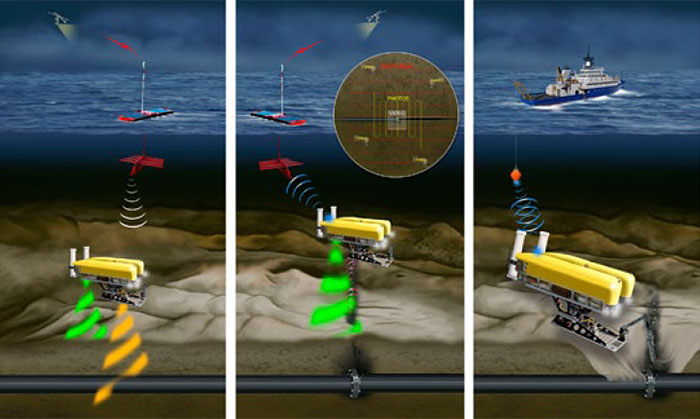Hybrid AUV inspection, monitoring, and intervention of seafloor and sub-seafloor pipelines
Minimizing the need for a surface vessel when working on seafloor and subseafloor pipelines presents opportunities to greatly reduce costs and improve response, a goal that is enabled by a range of technologies and methods pioneered by WHOI personnel over the years. These include developing and deploying high-mobility AUVs to conduct surveys and studies in close proximity to natural and manmade environmental hazards; experience detecting and quantifying physical and chemical changes in the marine environment; tetherless manipulation; extreme AUV mobility; autonomous surface vehicle (ASV) tracking; scalable communication; and AUV-based magnetic surveys.
A mature vision would include a highly maneuverable, hovering AUV equipped with low-powered mangnetometers and an ASV providing tracking and communications relay. The AUV would perform tasks including pipeline localization; detection and quantification of slumps, scours, and leaks; photo and video reconnaissance; and even contact-based measurements such as wall thickness. The AUV would collect data for later analysis and use onboard expert systems programmed with knowledge accumulated by WHOI personnel to make autonomous identification of seafloor and water column anomalies.
The AUV would be able to telemeter select data and status reports to and receive instructions from anywhere in the world through acoustic and satellite links on the ASV. In the event that the AUV identifies an anomaly (on its own or in collaboration with remote personnel) it could be commanded or pre-programmed to conduct a more detailed survey while it awaits the arrival of a surface support vessel. Upon arrival, a WHOI high-bandwidth optical communications package could be lowered to download the full survey data and turn the AUV into a light ROV that could provide real time video, direct remote control, and even light intervention capability while heavier assets are brought to the scene.
Principal Engineers
Carl Kaiser
Research Engineer, WHOI
Andy Bowen
Principal Engineer, WHOI
Richard Camilli
Associate Scientist, WHOI
Dana Yoerger
Senior Scientist, WHOI
Michael Jakuba
Research Engineer, WHOI
Norman Farr
Senior Engineer, WHOI

